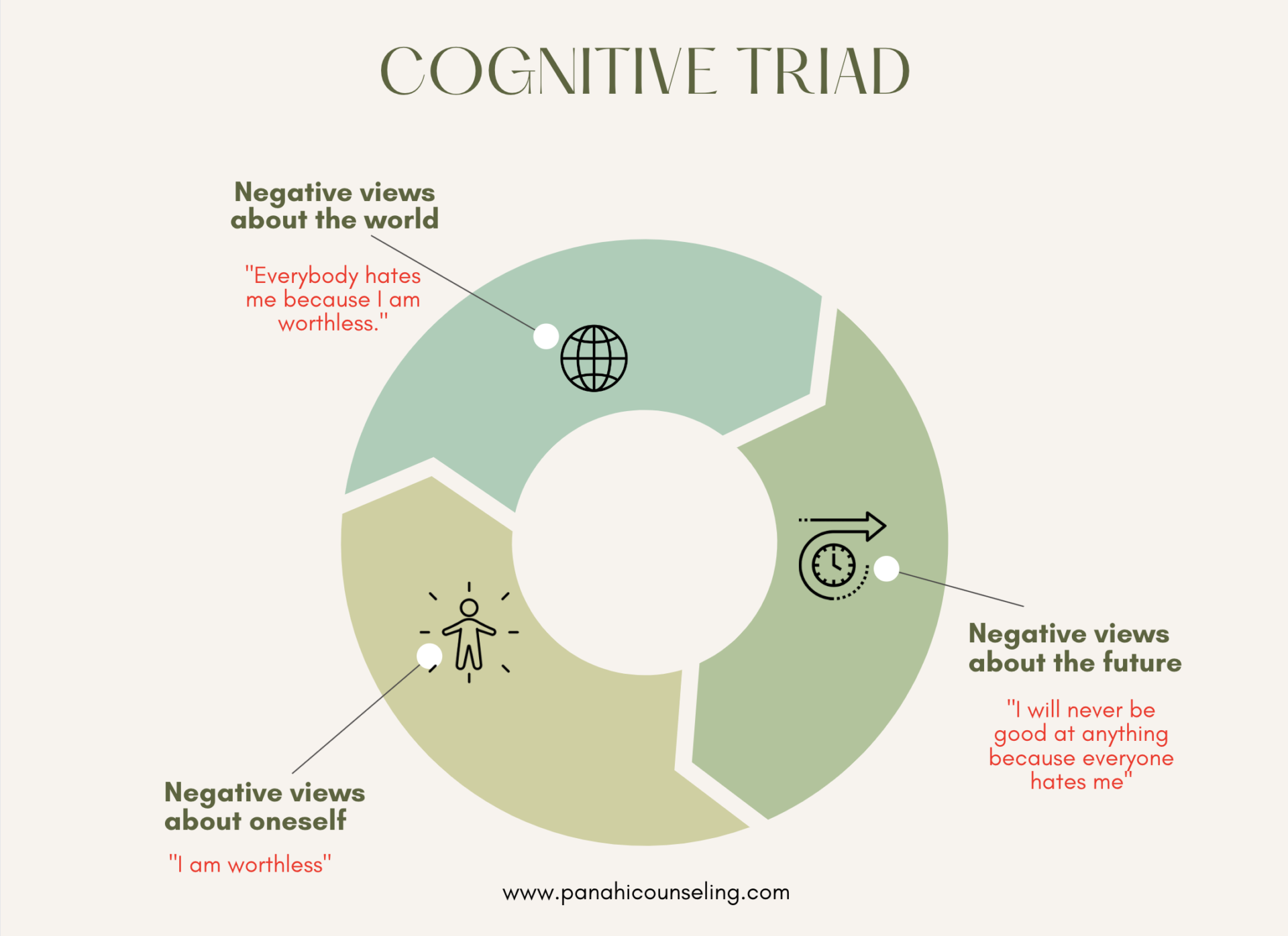Among all the theories and techniques in Psychotherapy, Cognitive Behavior Therapy (CBT) is one of the most researched approaches to treating anxiety, depression, and other mental illnesses. CBT primarily focuses on challenging and changing “the way we think” and “perceive the world,” often called Cognitive Distortion (a).
When exploring Cognitive Distortion, the role of thoughts, beliefs, and attitudes are examined to assess our emotional regulation and also formulate coping skills as a treatment goal (b). There are several key components to CBT that are worth exploring in detail. In the course of therapy, your therapist may refer to these components or might provide you with handouts designed as a homework tool.
10 Unhelpful Thinking Styles
In total, there are ten unhelpful thinking styles listed below (c). Each of these thinking styles can be identified through talk therapy and self-evaluation. Most of my clients can identify their unhelpful thinking styles upon a brief exploration.
- All-or-nothing thinking: This is also called ‘Black and White’ thinking. Individuals often believe that if they are not perfect, then they are a failure as a person.
- Mental filer: refers to only paying attention to a specific part of the situation and ignoring all the other relevant evidence. This is similar to Confirmation Bias (d), where we fixate on only certain information that supports our argument and belief about something.
- Jumping to conclusion: refers to either ‘mind-reading’ or ‘fortune telling’. In mind-reading, we assume what others are thinking; in fortune-telling, we tend to predict what might happen to us and others.
- Emotional reasoning: causes us to think that just because we feel this way, then it must be true. This form of thinking style causes us to behave unpredictably because we are at the mercy of our emotions and feelings at a given time.
- Labeling: refers to labeling ourselves and others with destructive labels (i.e., dumb, stupid, ugly). This is often a reaction to childhood abuse & neglect. Bullying and toxic peer relationships can also cause us to think that we are ‘a loser’, ‘an idiot’, or ‘unlovable’. Labeling can cause significant issues in intimate and peer relationships.
- Overgeneralizing: refers to our tendency to see patterns based on a single piece of evidence or being super broad in the conclusion we draw from the situation. We might think, ‘nothing good ever happens to us’ or ‘if I failed in biology class, I am done with school.’
- Disqualifying the positive: is the tendency to discount everything that is going right for us. We spend most of our energy deflecting and minimizing our good attributes.
- Magnification & Minimization: refer to either blowing things out of proportion (also called catastrophizing) or minimizing something to make it less important. This is commonly a self-protective shield we use to prepare ourselves for the doom and gloom of life.
- Should & Must: refers to being critical by using words like ‘should,’ ‘must,’ and ‘ought to’ to make ourselves and others feel guilty and shameful. This form of unhelpful thinking pattern is considered rigid thinking, and it can lead us to experience extreme unhappiness and dissatisfaction.
- Personalization: refers to blaming ourselves and taking responsibility for the things that are not our fault. This also refers to blaming others and deflecting responsibility.
What is Maladaptive Behavior?
From the evolutionary perspective, our maladaptive traits tend to be more harmful than helpful cumulatively (e). For example, our rigid thinking, which we explored above (should & must), can cause us and others significant distress when a situation requires that we be flexible and adaptive in a particular situation.
What is Cognitive Distortion
The founder of CBT, Aaron T Beck, believed that our negative outlook toward our reality significantly alters our attitude and behavior. He used the term schema (f), referring to the lens we see the world. Like a pair of dirty glasses that limits our view, negative schemas can alter how we see the world. He believed that challenging and changing these negative schemas could invite psychological flexibility (g) and happiness.

What is Cognitive Triad?
In the cognitive triad, three helpless and negative components interact with each other, impairing our perception, memory, and problem-solving abilities. The triad suggests a negative view of the ‘self,’ the ‘future,’ and the ‘world‘ (h). For example, ‘I am ugly” ( the self), ‘no one will love me’ (the world), and ‘I am a hopeless case because things will never change for me’ (the future).

What is Negative Self-Schema?
Aaron Beck believed that depression-prone individuals developed a negative self-schema (i). Possessing a set of beliefs and expectations has made the reality of such a person miserable. For example: ‘I need to be right all the time can lead someone to feel helpless when they cannot change the results of a less-than-perfect performance. In Psychotherapy, challenging negative schema can help individuals feel empowered and willing to try new things.
What CBT Techniques are Used in Therapy?
Identifying Core Beliefs tends to surface in the initial phase of therapy. Then, through interviewing and Socratic inquiry, your therapist will collaborate with you to identify each unhelpful thinking style. One thing to keep in mind is that this process is accomplished respectfully and compassionately. It does not feel like interrogation or feeling scrutinized in the session. Also, it may take anywhere from 1 session to several sessions to identify core beliefs.
1) Identifying Negative Thoughts & Challenging
Identifying Negative Thoughts & Challenging them is one of the initial interventions used in the CBT approach. Your therapist will provide you with a worksheet asking you to record the ‘situation,’ related ‘thoughts,’ ’emotions,’ ‘behavior,’ ‘alternative thoughts,’ and the ‘thinking errors’ used in the situation.

2) Socratic questioning Method
Through Socratic questioning, another worksheet is used to ask the evidence for having a certain form of irrational or rational thoughts. For example, you may be asked to evaluate strong emotions and feelings using a worksheet with the following questions:
- Is there substantial evidence for your thought?
- Is there evidence contrary to your thought?
- Are you attempting to interpret the situation without all the evidence?
- What would a friend think about this situation?
- If you look at the situation positively, how is it different?
- Will this matter a year from now? How about five years from now?
3) Decatastrophizing
Another technique used in CBT therapy is called Decatastrophizing (j) the situation. Your therapist will ask you to identify irrational thoughts and beliefs and use the following question to identify their exaggerated nature.
- What are you worried about?
- How likely is it that your worry will come true? You may be asked to give an example of a past experience and evidence to support your claim.
- What is the worst that could happen if your worry does come true?
- If your worry does come true, what is most likely to happen?
- If your worry comes true, what are the chances you will be ok in one week, month, or year?
Strengths of Cognitive Behavior Therapy
- CBT approach has a great appeal because it is measurable and structured. Your therapist can recommend many CBT workbooks as supplementary reading.
- The theory works well for cases of depression, anxiety, Substance Abuse, phobia, OCD, and sexual disorders. CBT is also effective in relationship therapy.
- CBT works well for clients committed to homework outside the therapy session.
Limitations of Cognitive Behavior Therapy
- CBT treatment has its limitations when working with individuals limited with insight and self-awareness.
- CBT tends to have a narrow scope – only focusing on one aspect of human functioning: thinking. As human beings, we have much broader parts and environments influencing our reality and behavior.
- Sometimes CBT can seem confrontational, especially when a client is not invested in engaging with the CBT approach. If this happens, it is crucial to inform your therapist about your experience.
A Final Word On Cognitive Behavior Therapy Approach
As a psychotherapist, I acknowledge that CBT has many helpful components that can enrich the therapy process. However, we need to understand that CBT is only one theory of many forms of theories and techniques used in counseling and therapy. At Panahi Counseling, our therapists are equipped to approach treatment from an eclectic approach (k), addressing the client’s unique and entire reality (i.e., biological, psychological, environmental, and relationships). Mental health concerns are multifaceted and should be addressed as such.
Related Blogs
Share Post:
Therapy, anywhere, at your pace.
schedule A free Consultation Today.



